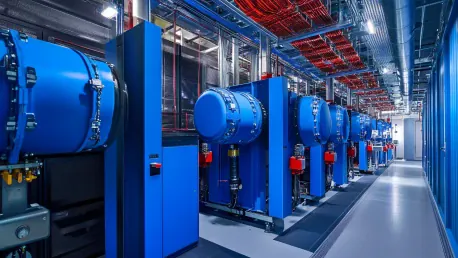Data centers have become a crucial part of the modern digital landscape, underpinning everything from cloud computing to artificial intelligence (AI). However, as these facilities multiply and expand to meet the ever-growing demand for data storage and processing, they introduce significant environmental challenges. Traditional data centers consume enormous amounts of energy, primarily sourced from non-renewable resources, and rely heavily on water-based cooling systems. These factors contribute to substantial environmental impacts. Microsoft’s latest endeavor—introducing a zero-water datacenter design—seeks to address these concerns by implementing innovative cooling technologies that eliminate the need for water while also enhancing sustainability.
Understanding the Challenges of Datacenter Cooling
Environmental Strain from Energy Consumption
The digital age has transformed how we live and work, driven largely by advancements in cloud computing and AI. However, the data centers that power these technologies come with an immense appetite for energy. Most of this energy is derived from non-renewable sources like coal and natural gas, which release significant amounts of CO2 into the atmosphere. This makes data centers a notable contributor to global greenhouse gas emissions. Additionally, maintaining optimal operating temperatures within these facilities requires extensive use of air conditioning and other cooling methods, further exacerbating their environmental footprint. As data centers continue to proliferate, the strain on our energy resources and the corresponding environmental impact is expected to grow.
Traditional Cooling Methods and Their Impact
For years, data centers have relied on conventional cooling methods, such as air conditioning and water-based systems, to dissipate the heat generated by servers and other hardware. These traditional cooling methods are highly effective but come at a considerable environmental cost. Air conditioning units often run on electricity produced from fossil fuels, thereby contributing to greenhouse gas emissions. Water-based cooling systems, on the other hand, require vast quantities of water, which can lead to significant local water scarcity issues. In many regions, the water used for cooling is drawn from freshwater sources, creating a strain on local ecosystems and community water supplies. This reliance on water-intensive cooling methods underscores the urgent need for more sustainable solutions.
Microsoft’s Solution: Next-Generation Datacenter Design
Introduction of Chip-Level Cooling Solutions
In a groundbreaking move, Microsoft is addressing both the energy and water consumption concerns of data centers by introducing chip-level cooling solutions. This next-generation design employs a zero-water evaporative cooling system that operates on a closed-loop mechanism. Unlike traditional systems that require a continuous supply of fresh water, Microsoft’s innovative approach recycles the water within the system, significantly reducing the need for additional resources and lowering contamination risks. This closed-loop design not only supports the company’s sustainability efforts but also optimizes energy efficiency. By focusing on chip-level cooling, Microsoft addresses the critical area of heat generation directly at its source, making the overall datacenter infrastructure much more efficient.
Managing AI Workloads and Environmental Impact
The zero-water cooling system is particularly vital for managing the high workloads associated with AI and other intensive computing tasks. AI applications are known for their extensive processing requirements, which generate significant amounts of heat. Traditional cooling methods often struggle to keep pace with the demands of modern AI workloads, but Microsoft’s innovative cooling system ensures optimal performance without compromising environmental sustainability. By lowering Water Usage Effectiveness (WUE) and enhancing resource conservation, especially in water-stressed regions, Microsoft is taking a significant step forward in aligning technological advancement with environmental stewardship. This new system promises to not only maintain performance standards but also significantly reduce the environmental impact of data center operations.
Benefits and Challenges of Zero-Water Cooling Technology
Advantages of Zero-Water Cooling
The primary advantage of Microsoft’s zero-water cooling technology is its alignment with broader sustainability goals. By drastically reducing Water Usage Effectiveness (WUE), this system directly contributes to conserving vital resources, especially in areas where water scarcity is a pressing concern. Traditional water cooling systems typically consume vast amounts of water, which can deplete local water supplies and negatively impact ecosystems. Microsoft’s closed-loop cooling system alleviates these issues by recycling water within the system. This innovative approach helps to maintain ecological balance and reduces the operational risks associated with water shortages. Additionally, the zero-water cooling technology supports the company’s broader commitment to reducing its overall environmental footprint and promoting sustainable practices across its operations.
Challenges in Implementation
While the benefits of zero-water cooling are substantial, its implementation is not without challenges. The transition from water-based to mechanical cooling solutions involves a complex network of tiny pipes and heat exchangers at the chip level. This intricate design increases both the complexity and the cost of the system. Mechanical cooling, although effective in reducing water use, demands substantial amounts of energy to operate. This poses a different set of environmental challenges, as the energy required for mechanical cooling could, if not sourced from renewable resources, negate some of the environmental benefits. To overcome these challenges, Microsoft must explore advanced solutions for energy efficiency, ensuring that the overall environmental impact of their datacenters is minimized.
Environmental and Community Impact
Conservation of Local Ecosystems
One of the most significant benefits of Microsoft’s zero-water cooling technology is its potential to conserve local ecosystems. Traditional datacenter cooling methods often rely heavily on local water sources, drawing large quantities of water for cooling purposes. This can lead to the depletion of local water resources, adversely affecting aquatic life and ecosystems. Microsoft’s closed-loop system significantly reduces the need for fresh water, helping to mitigate these adverse effects. By recycling water within the cooling system, Microsoft can maintain ecological balance and ensure that its datacenter operations do not disrupt local water supplies. This approach not only supports environmental sustainability but also enhances the resilience of local communities by preserving vital water resources.
Commitment to Sustainable Practices
Microsoft’s focus on zero-water cooling is part of a broader commitment to sustainable practices that balance technological growth with environmental responsibility. By implementing innovative cooling solutions, Microsoft aims to minimize the environmental impact of its datacenters while maintaining high performance standards. This commitment to sustainability extends beyond cooling technology to encompass the entire operational lifecycle of Microsoft’s datacenters. From energy-efficient hardware to renewable energy sourcing, Microsoft’s efforts demonstrate a holistic approach to reducing its environmental footprint. By adopting these sustainable practices, Microsoft sets a positive example for the tech industry, showcasing how technological advancements can be achieved without compromising environmental health.
Global Implementation and Future Prospects
Piloting the New Design
Microsoft’s commitment to sustainable data management is evident in its plans to pilot the new zero-water cooling design in various datacenters around the world. The company aims to implement these innovative solutions in select locations by 2027, reflecting a significant investment in setting new industry standards for environmental responsibility. By testing the new design in diverse environments, Microsoft can gather valuable data and insights to refine and optimize the cooling system for broader deployment. The goal is to achieve near-zero Water Usage Effectiveness (WUE), positioning Microsoft as a leader in eco-conscious innovations within the data management sector.
Setting Industry Standards
The successful implementation of the zero-water cooling system has far-reaching implications for the tech industry. By demonstrating the feasibility and benefits of such innovative cooling solutions, Microsoft sets a benchmark for other companies to follow. The shift towards more sustainable datacenter operations not only helps in reducing the carbon footprint but also aligns with global sustainability goals. As other tech companies adopt similar practices, the cumulative impact on reducing environmental degradation could be substantial. Microsoft’s dedication to continuously refining and expanding these innovations underscores its commitment to environmental stewardship, paving the way for widespread adoption of sustainable technologies in data processing and management.
Renewable Energy Integration and Efficiency
Importance of Renewable Energy
For the zero-water cooling technology to maximize its environmental benefits, it is crucial that the energy required to operate these systems comes from renewable sources. Integrating renewable energy sources like solar and wind power is essential to maintaining the overall sustainability of the cooling system. Without this integration, the environmental gains achieved through water conservation could be offset by the increased energy consumption from non-renewable sources. Microsoft’s sustainability vision includes a focus on utilizing clean energy to power its datacenter operations, ensuring that the benefits of the zero-water cooling technology are fully realized.
Advanced Solutions for Power Consumption
To further enhance the efficiency of the zero-water cooling system, Microsoft is exploring advanced solutions to minimize power consumption. One such solution is the use of high-efficiency economizing chillers, which can significantly reduce the amount of energy required for cooling. These chillers are designed to utilize ambient air temperatures to cool the datacenter, reducing reliance on mechanical cooling systems. By integrating these advanced technologies, Microsoft aims to create a more energy-efficient datacenter infrastructure that aligns with its sustainability goals. This holistic approach ensures that the environmental benefits of the zero-water cooling system are maximized, contributing to a more sustainable and eco-friendly data management industry.
Long-Term Sustainability Goals
Historical Commitment to Sustainability
Microsoft’s introduction of zero-water cooling technology is the latest in a series of initiatives aimed at reducing the company’s environmental footprint. Since the early 2000s, Microsoft has been committed to lowering water use and carbon emissions across its datacenter operations. This long-term focus on sustainability is evident in various projects and innovations that prioritize resource conservation and environmental stewardship. By consistently striving to improve the efficiency and sustainability of its operations, Microsoft has established itself as a leader in the tech industry’s shift towards greener practices.
Achieving Significant Reductions
The development and implementation of zero-water cooling technology represent a significant milestone in Microsoft’s journey toward sustainability. Compared to traditional datacenter models, the new cooling system achieves an 80% reduction in water use, underscoring the company’s commitment to conserving vital resources. This advancement continues Microsoft’s trajectory of pioneering sustainable methods in the tech industry, setting a high standard for other companies to follow. By promoting these innovative and environmentally friendly solutions, Microsoft aims to drive the industry toward a future where technology and sustainability go hand in hand, ensuring that progress does not come at the expense of the planet.
Conclusion
Data centers play a pivotal role in today’s digital world, supporting everything from cloud computing to artificial intelligence (AI). However, the rapid expansion of these facilities to cater to increasing demands for data storage and processing brings significant environmental issues. Traditional data centers consume vast amounts of energy, mostly derived from non-renewable sources, and depend heavily on water-based cooling systems. These practices lead to considerable environmental impacts. Microsoft’s newest initiative aims to tackle these problems with the introduction of a zero-water data center design. This innovative approach utilizes advanced cooling technologies, eliminating the need for water and promoting greater sustainability. The move is part of Microsoft’s broader commitment to reducing its environmental footprint and advancing eco-friendly technology solutions. As data centers continue to grow in number and size, such green innovations are essential for balancing technological progress with environmental preservation. By turning to sustainable practices, Microsoft sets an example for the industry, highlighting that it is possible to meet burgeoning data demands while also being mindful of the planet’s resources.









